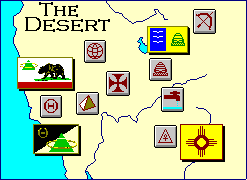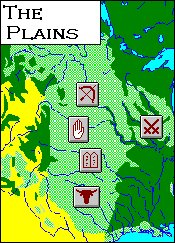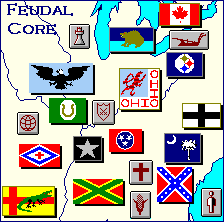 The Desert is a pretty vast region of Medieval America. And to both our 21st century Americans, and even Medieval Americans of the East, it may be the most bizarre. Encompassing much of the southwest, these people have been isolated from much of the rest of the world, and have had to adapt to adapt and forsake a culture that could only be maintained through modern machines. The most distinct thing about denizens here, from what we can tell so far, is that they have wildly different religions. Religion seems to be the best way to divide the three nations, if not states up. When White mentions peoples west of the Rockies, he seems to emphasize the religion. Some places, like Colorado and Nevada look to have three religions within their former borders, but that might not be a case of friction so much as petering out. In fact, Nevada itself seems to withered away, with no tourism industry, or technology to divert the rivers. The settlements of the desert may have suffered the most traumatic transition into this era, as the southwest is home to many bustling and growing cities, with the relative lack of resources to support it. It's said these places might never have attracted people in the first place if air conditioning wasn't invented. The climb back to the top must have been harsh, maybe even gruesome at times, but now we're witness to the colorful societies that have been forged.
The lifestyle icon is a water pump denoting "irrigation". White has dropped reference to the fact farmers need to irrigate their land, building canals from rivers to farms in order to grow crops. The sunlight and lack of parasites make up for the shallow soils, but agriculture remains intensive. Civilizations pretty much appear on the river banks and nations are long, narrow bends and arcs. It's likely that not only do the rivers serve as the bases for farming, but also transport and fleets. This is another reason hydraulic empires are able to thrive with absolute authority. Cities are very condensed and consolidated. White doesn't have any pictures, even in the archive, of what people in the desert look like, but it wouldn't be too hard to speculate. It is very likely there's a mix and match between the cowboys and the southern farmers, with some veering to one end of the scale depending on the warmth of the area. In general, this should be considered less of a Sahara-type desert that evokes giant blistering sand dunes, but one where cold is much of a threat as heat. Ice may also be feasible for the wealthy to access, which could affect society in several ways.
Most of the population of Mexico is found in the more forested, south, and the "border towns" of the desert are now firmly nomadic. In my opinion, this means that the territory is relatively up for grabs. Why would a nation want this area? Well, I think they would want the area around the Baja peninsula. Trade with South America probably shapes the mobility and initiative of the north, and the Gulf of California would make an excellent trade route without having to traverse the inland deserts. The main problem is how arid Death Valley is. These would not be great sources of agriculture for the region--they would be trade cities, plain and simple. A breakdown in trade, or a wane in demand for the goods would see such cities wither and die.
The Desert is a pretty vast region of Medieval America. And to both our 21st century Americans, and even Medieval Americans of the East, it may be the most bizarre. Encompassing much of the southwest, these people have been isolated from much of the rest of the world, and have had to adapt to adapt and forsake a culture that could only be maintained through modern machines. The most distinct thing about denizens here, from what we can tell so far, is that they have wildly different religions. Religion seems to be the best way to divide the three nations, if not states up. When White mentions peoples west of the Rockies, he seems to emphasize the religion. Some places, like Colorado and Nevada look to have three religions within their former borders, but that might not be a case of friction so much as petering out. In fact, Nevada itself seems to withered away, with no tourism industry, or technology to divert the rivers. The settlements of the desert may have suffered the most traumatic transition into this era, as the southwest is home to many bustling and growing cities, with the relative lack of resources to support it. It's said these places might never have attracted people in the first place if air conditioning wasn't invented. The climb back to the top must have been harsh, maybe even gruesome at times, but now we're witness to the colorful societies that have been forged.
The lifestyle icon is a water pump denoting "irrigation". White has dropped reference to the fact farmers need to irrigate their land, building canals from rivers to farms in order to grow crops. The sunlight and lack of parasites make up for the shallow soils, but agriculture remains intensive. Civilizations pretty much appear on the river banks and nations are long, narrow bends and arcs. It's likely that not only do the rivers serve as the bases for farming, but also transport and fleets. This is another reason hydraulic empires are able to thrive with absolute authority. Cities are very condensed and consolidated. White doesn't have any pictures, even in the archive, of what people in the desert look like, but it wouldn't be too hard to speculate. It is very likely there's a mix and match between the cowboys and the southern farmers, with some veering to one end of the scale depending on the warmth of the area. In general, this should be considered less of a Sahara-type desert that evokes giant blistering sand dunes, but one where cold is much of a threat as heat. Ice may also be feasible for the wealthy to access, which could affect society in several ways.
Most of the population of Mexico is found in the more forested, south, and the "border towns" of the desert are now firmly nomadic. In my opinion, this means that the territory is relatively up for grabs. Why would a nation want this area? Well, I think they would want the area around the Baja peninsula. Trade with South America probably shapes the mobility and initiative of the north, and the Gulf of California would make an excellent trade route without having to traverse the inland deserts. The main problem is how arid Death Valley is. These would not be great sources of agriculture for the region--they would be trade cities, plain and simple. A breakdown in trade, or a wane in demand for the goods would see such cities wither and die.
White has actually given two of the three desert kingdoms their own pages, leaving only New Mexico mystery. The territory has extended into Arizona, and even some of Texas. The desert shepherds and goatherds may play a very large role in New Mexico. The husbandry map combined with the West Map shows that within New Mexico's borders, we see quite a few nomadic tribes. They may even make up half the population. This is kind of fitting as New Mexico and Arizona have always been more "Wild West" than the other desert states, and still boast a few ranches. Most are probably shepherds and goatherds, but it might be possible there are cattlers here and there. Another interesting thing is that the major cities seem to mostly be in the eastern half of the nation. However, there are settlements on the Gila river. I wonder if they're more spread out, and most resemble the old Native American cultures which have likely blurred over history. The religion map says "New Age", and I'm not sure what that is, or why primarily Catholic New Mexico would be practicing that. It's possible that, with the sun belt's collapse, people were looking for drastic new answers. The religions of the modern westerns world come mostly from the desert (The same desert, in fact), so it probably makes sense that if anything dramatically different were to pop up, here would be the place. And it would probably take just one eccentric autocrat to impose his new faith one everybody.
Speaking of which, while White has talked about Deseret and California specifically, he hasn't really gotten into their respective faiths. I'll get into them on the religions page, but both are real world religions, and considered by some to be especially peculiar. The Church of Latter Days Saints established a foothold in the settler days, and today Utah and its surrounding areas are very strongly and uniquely Mormon country. In addition to its demographics, isolation, and that harder times are Churchy times, that Mormons tend to have survivalist leanings makes its endurance into Medieval America all the more logical. Probably the biggest contributors to Hurricane Katrina relief were Mormon organizations. The Church of Scientology's prominence is a little more of a headscratcher. There are not any adherents, (and in the days since White first created it site, it has suffered P.R. disaster after disaster.) This maybe trying to take the stereotype of the Los Angeles airhead to its logical conclusion, and that it's the religion most associated with movie stars may mean a sort of sci-fi, movie inspired religious doctrine. I would bet Emperors often claim they're made into stars upon death--and local astronomers are bribed to name stars after their recently departed rulers.
The "desert" graphic has horse archery as the prime mode of combat but from all appearances Desert and California have their share of heavy cavalry. Because there's no "knightly" class in the Hydraulic Empires, and it appears the armies must be celibate, and because their general is also their spiritual leader, I've presumed that the warriors here operate much like the Knights Templar (Who also got their start in the arid Crusader States), and considering the Church of Latter Days Saints calls their HQ a Temple, my own creative contribution to the Medieval American World is that "Templar" is a unique sort of class of celibate, desert-based lancers



